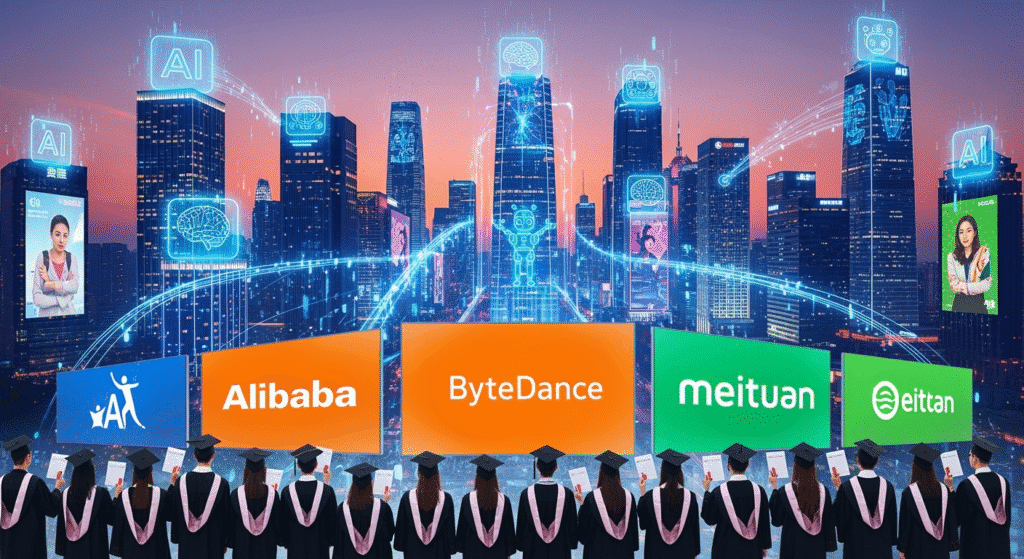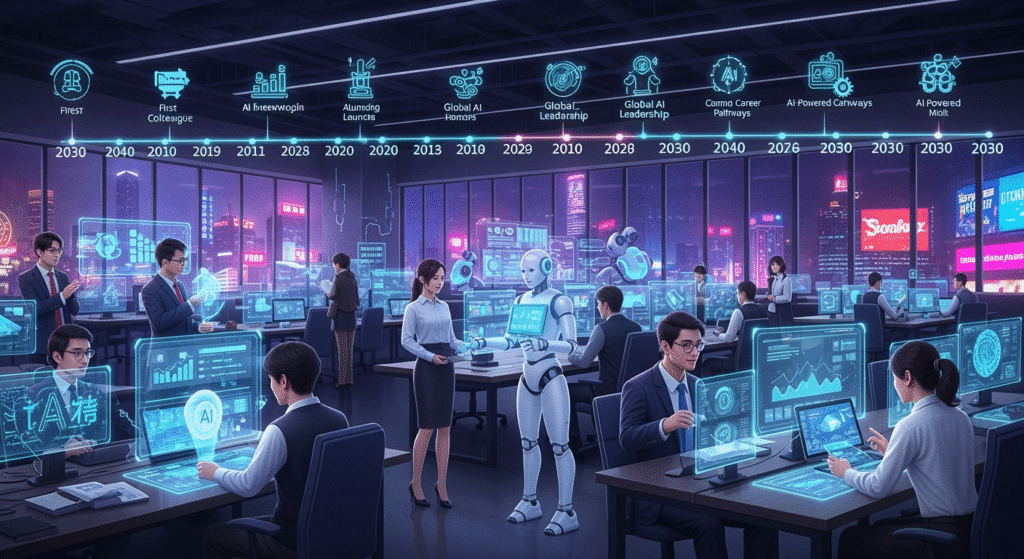The artificial intelligence boom is reshaping China’s job market in unprecedented ways. Major technology companies are launching their most aggressive recruitment campaigns ever, targeting fresh graduates with thousands of positions focused on AI development and innovation.

The Numbers Tell the Story
China’s tech titans are making bold moves in their quest for AI talent. Alibaba officially launched its fall recruitment campaign, announcing plans to make more than 7,000 job offers across its 15 business groups and companies. What’s striking is the focus: over 60 percent of these positions are AI-related.
The numbers get even more impressive when you look at specific divisions. Alibaba Cloud, Alibaba International, and DingTalk are dedicating 80 percent of their openings to AI roles. Amap follows closely with 75 percent of positions focused on artificial intelligence and related technologies.
ByteDance isn’t holding back either. The TikTok parent company announced over 5,000 job opportunities, representing a significant 25 percent increase from last year’s recruitment drive. Research and development positions alone saw a 23 percent year-on-year boost.
The AI Talent Gold Rush
This hiring frenzy reflects a deeper transformation happening across China’s technology landscape. Companies aren’t just expanding their workforce they’re fundamentally restructuring their talent acquisition strategies around artificial intelligence capabilities.
Taobao and Tmall Group under Alibaba made their priorities crystal clear. Technical roles account for 90 percent of their 2026 autumn recruitment positions, with a laser focus on nurturing algorithm and AI talent starting from campus recruitment.
The competition extends beyond these two giants. Meituan jumped into the race on July 29, launching campus recruitment for 2026 with 6,000 offers covering more than 100 positions across 10 categories. The company specifically highlighted its demand for global AI talent.
Why the Sudden Urgency?
The enhanced demand for AI professionals comes amid widespread adoption of AI technologies across multiple sectors. Liu Dingding, a veteran tech industry analyst, explains that this expansion reflects “the country’s continuous innovation and growing technological advantages.”
The data supports this assessment. In 2024, the number of Chinese enterprises developing or applying AI grew by 36 percent year-on-year. The first half of 2025 saw AI-related job postings surge by more than 40 percent compared to the same period in 2024.
Even more telling is the 57 percent increase in job postings requiring proficiency with large-scale AI models. This isn’t just about hiring more people it’s about finding individuals with cutting-edge skills in the most advanced AI technologies.
The Talent Shortage Crisis
Despite the aggressive hiring campaigns, China faces a significant challenge. AI-related positions are currently the most talent-starved in the country, with a supply-demand ratio well below 1.0.
The numbers paint a stark picture. McKinsey & Company forecasts that China will require 6 million AI professionals by 2030 but could face a shortfall of 4 million. This massive gap explains why companies are moving so aggressively to secure talent early.
Professional networking platform Maimai confirms this scarcity, noting that the supply-to-demand ratio for AI talent stands at just 0.5. This means there’s only one suitable candidate for every two AI positions available.
Educational Response and Industry Collaboration
Recognizing the talent gap, China’s educational institutions are stepping up their efforts. More than 500 universities now offer AI-related majors or have launched dedicated schools in the field. Prestigious institutions like Tsinghua University and Renmin University of China included AI in their 2025 enrollment expansion plans.
Nankai University took a particularly aggressive approach, introducing more than 130 specialized courses under its AI talent development initiative last year. This represents a fundamental shift in how Chinese universities are approaching technology education.
Pan Helin, a member of the Expert Committee for the Information and Communication Economy under the Ministry of Industry and Information Technology, emphasizes the importance of industry-academia collaboration. He notes that China is “actively promoting the integration of industry, academia and research, encouraging collaboration between universities and enterprises.”
Compensation and Competition Intensify
The talent shortage is driving up compensation across the board. From January to February 2025, the three highest-paying roles among common tech job postings were large language model algorithm engineers, earning an average of 68,051 yuan ($9,465) per month.
AI engineers followed closely at 60,768 yuan monthly, while algorithm engineers commanded 52,381 yuan per month. These figures represent significant premiums over traditional technology roles.
ByteDance’s TopSeed Talent program exemplifies this trend toward premium compensation. The program targets outstanding PhD candidates and research interns in AI fields, offering a daily wage of 2,000 yuan ($278). With 20 working days per month, interns could earn up to 40,000 yuan well above industry standards.
Global Talent Acquisition Strategies
The competition isn’t limited to domestic talent. Chinese tech giants are increasingly looking overseas for AI expertise. Alibaba recently recruited Steven Hoi Chu-hong, a top global AI scientist and former Salesforce Group Vice President, to lead foundational research on multimodal models and AI agents.
ByteDance made a similar high-profile acquisition by recruiting Yonghui Wu, a veteran Google researcher who worked at the U.S. company for 17 years. Wu now serves as head of foundational research for ByteDance’s large model team Seed, focusing on large language models and generative AI.
These moves signal a broader strategy among Chinese tech companies to compete globally for the world’s top AI talent, regardless of nationality or previous employer.
Regional and Local Support Initiatives
The talent acquisition battle extends beyond individual companies to regional competition. Many local governments are implementing measures to retain AI professionals by addressing housing, social security, and talent subsidies.
This coordinated approach between private companies and government entities creates a comprehensive ecosystem designed to attract and retain AI talent. The strategy recognizes that successful AI development requires not just competitive salaries but also supportive living and working environments.
Looking Ahead: The Future of AI Employment

The current hiring surge represents more than a temporary market adjustment. It signals a fundamental shift in how Chinese technology companies view their future growth prospects and competitive positioning.
The focus on campus recruitment is particularly strategic. By targeting 2026 graduates, companies are investing in talent that will mature alongside AI technologies over the next decade. This long-term thinking suggests that the current hiring boom is just the beginning of a sustained transformation in China’s technology workforce.
As AI continues to reshape industries from e-commerce to cloud computing, the companies that successfully attract and develop top talent today will likely dominate tomorrow’s technology landscape. The massive recruitment campaigns launched by Alibaba, ByteDance, and their competitors represent strategic investments in that future.
The implications extend far beyond individual companies or even the technology sector. China’s ability to develop AI talent at scale will significantly influence its position in the global technology competition and its capacity to lead in the next phase of digital innovation.
Sources
- Global Times – China’s tech giants kick off fall recruitment by focusing on AI talent
- TechNode – China’s tech giants kick off 2026 grad hiring drive early, AI roles in high demand
- South China Morning Post – Alibaba, ByteDance kick off campus recruitment campaigns as AI drives growth
- Yicai Global – TikTok Owner ByteDance Boosts Campus Hiring by 25% to Tackle AI Talent Crunch
- TrendForce – AI Talent Race Heats Up in China as Xiaomi, ByteDance, and Alibaba Compete for Experts










Comments 1